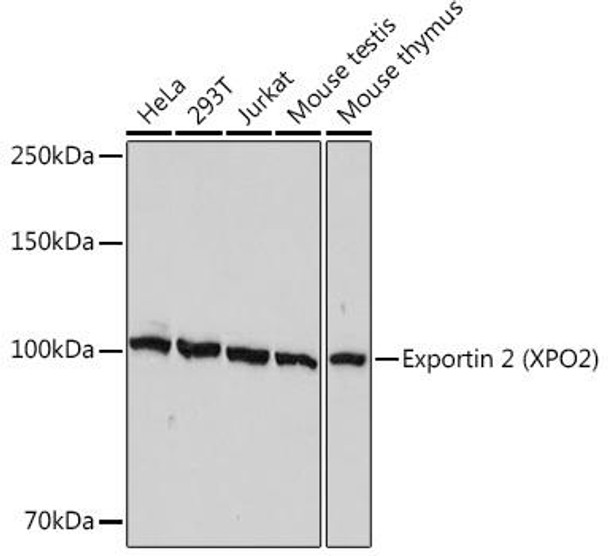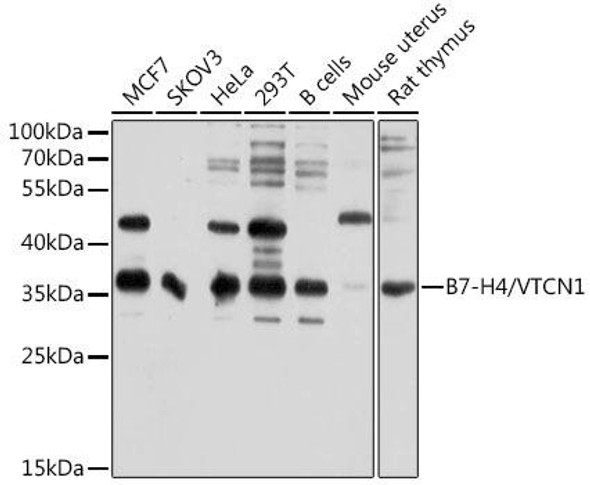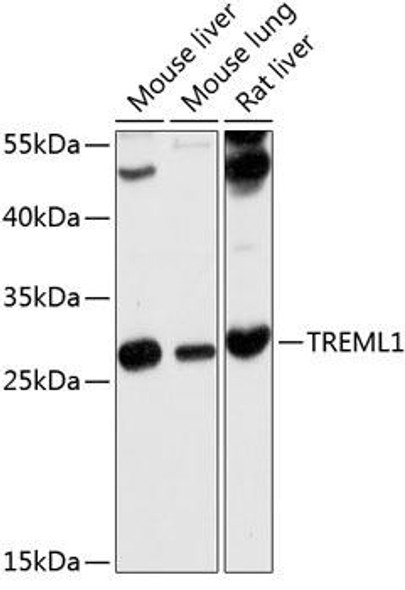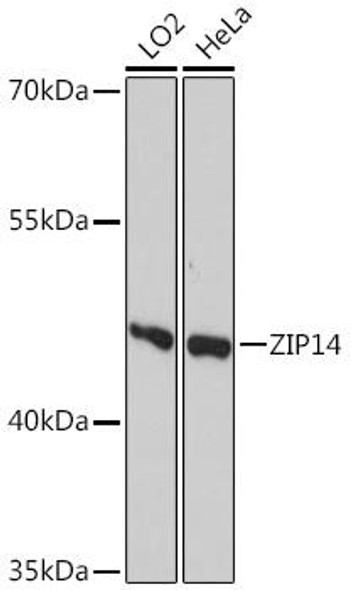Anti-Exportin 2 (XPO2) Antibody (CAB1041)
- SKU:
- CAB1041
- Product type:
- Antibody
- Antibody Type:
- Monoclonal Antibody
- Reactivity:
- Human
- Mouse
- Host Species:
- Rabbit
- Isotype:
- IgG
- Synonyms:
- CAS
- CSE1
- XPO2
Frequently bought together:
Description
| Product Name: | Exportin 2 (XPO2) Rabbit mAb |
| Product Code: | CAB1041 |
| Size: | 20uL, 50uL, 100uL |
| Synonyms: | CAS, CSE1, XPO2 |
| Applications: | WB |
| Reactivity: | Human, Mouse |
| Host Species: | Rabbit |
| Immunogen: | A synthesized peptide derived from human Exportin 2 (XPO2) |
| Applications: | WB |
| Recommended Dilutions: | WB 1:500 - 1:2000 |
| Reactivity: | Human, Mouse |
| Positive Samples: | HeLa, 293T, Jurkat, Mouse testis, Mouse thymus |
| Immunogen: | A synthesized peptide derived from human Exportin 2 (XPO2) |
| Purification Method: | Affinity purification |
| Storage: | Store at -20°C. Avoid freeze / thaw cycles. Buffer: PBS with 0.02% sodium azide, 0.05% BSA, 50% glycerol, pH7.3. |
| Isotype: | IgG |
| Sequence: | Email for sequence |
| Gene ID: | 1434 |
| Uniprot: | P55060 |
| Cellular Location: | Cytoplasm, Nucleus |
| Calculated MW: | 98kDa |
| Observed MW: | 105kDa |
| UniProt Protein Function: | Exportin-2: Export receptor for importin-alpha. Mediates importin- alpha re-export from the nucleus to the cytoplasm after import substrates (cargos) have been released into the nucleoplasm. In the nucleus binds cooperatively to importin-alpha and to the GTPase Ran in its active GTP-bound form. Docking of this trimeric complex to the nuclear pore complex (NPC) is mediated through binding to nucleoporins. Upon transit of a nuclear export complex into the cytoplasm, disassembling of the complex and hydrolysis of Ran-GTP to Ran-GDP (induced by RANBP1 and RANGAP1, respectively) cause release of the importin-alpha from the export receptor. CSE1L/XPO2 then return to the nuclear compartment and mediate another round of transport. The directionality of nuclear export is thought to be conferred by an asymmetric distribution of the GTP- and GDP-bound forms of Ran between the cytoplasm and nucleus. Belongs to the XPO2/CSE1 family. 3 isoforms of the human protein are produced by alternative splicing. |
| UniProt Protein Details: | Protein type:Nuclear export; Karyopherin; Nuclear import Chromosomal Location of Human Ortholog: 20q13 Cellular Component: cytoplasm; cytosol; membrane; nuclear envelope; nucleoplasm; nucleus Molecular Function:nuclear export signal receptor activity; protein binding Biological Process: apoptosis; cell proliferation; protein import into nucleus |
| NCBI Summary: | Proteins that carry a nuclear localization signal (NLS) are transported into the nucleus by the importin-alpha/beta heterodimer. Importin-alpha binds the NLS, while importin-beta mediates translocation through the nuclear pore complex. After translocation, RanGTP binds importin-beta and displaces importin-alpha. Importin-alpha must then be returned to the cytoplasm, leaving the NLS protein behind. The protein encoded by this gene binds strongly to NLS-free importin-alpha, and this binding is released in the cytoplasm by the combined action of RANBP1 and RANGAP1. In addition, the encoded protein may play a role both in apoptosis and in cell proliferation. Alternatively spliced transcript variants have been found for this gene. [provided by RefSeq, Jan 2012] |
| UniProt Code: | P55060 |
| NCBI GenInfo Identifier: | 62297557 |
| NCBI Gene ID: | 1434 |
| NCBI Accession: | P55060.3 |
| UniProt Secondary Accession: | P55060,O75432, Q32M40, Q9H5B7, Q9NTS0, Q9UP98, Q9UP99 Q9UPA0, A3RLL6, B2R5T4, E1P5Y0, F8W904, |
| UniProt Related Accession: | P55060 |
| Molecular Weight: | 103,879 Da |
| NCBI Full Name: | Exportin-2 |
| NCBI Synonym Full Names: | chromosome segregation 1 like |
| NCBI Official Symbol: | CSE1L |
| NCBI Official Synonym Symbols: | CAS; CSE1; XPO2 |
| NCBI Protein Information: | exportin-2 |
| UniProt Protein Name: | Exportin-2 |
| UniProt Synonym Protein Names: | Cellular apoptosis susceptibility protein; Chromosome segregation 1-like protein; Importin-alpha re-exporter |
| UniProt Gene Name: | CSE1L |
| UniProt Entry Name: | XPO2_HUMAN |








